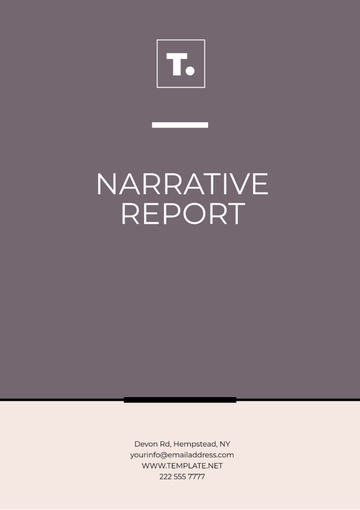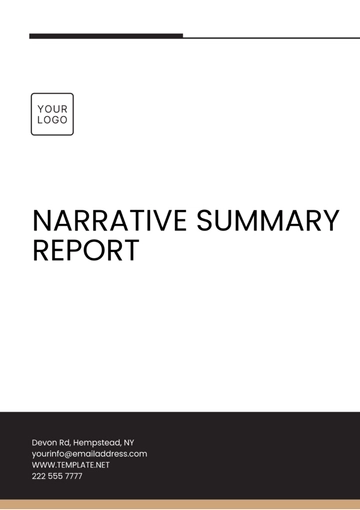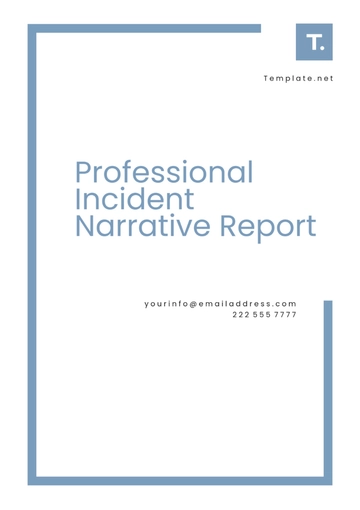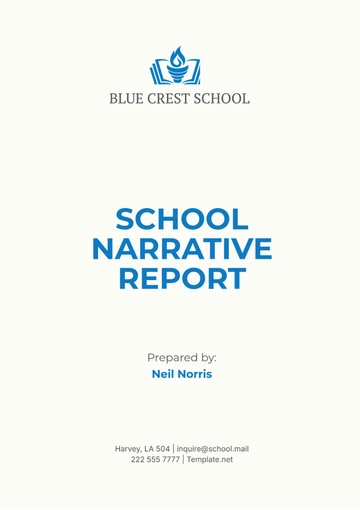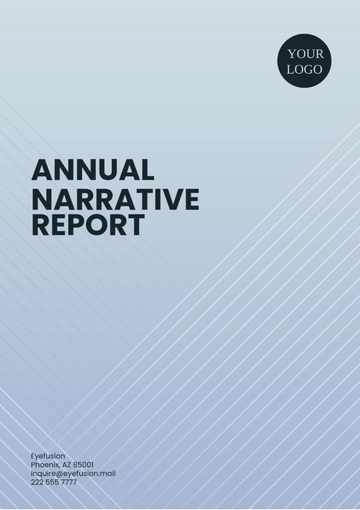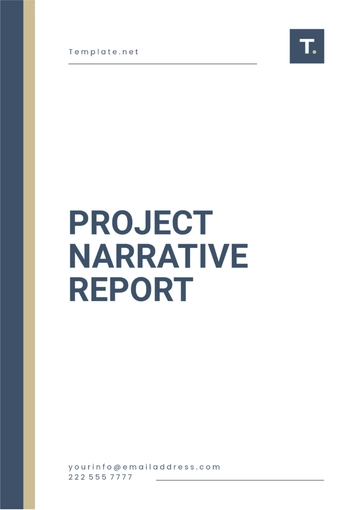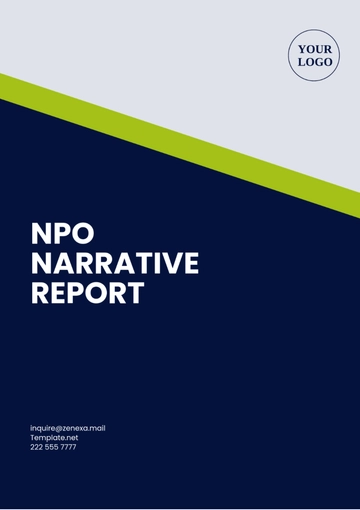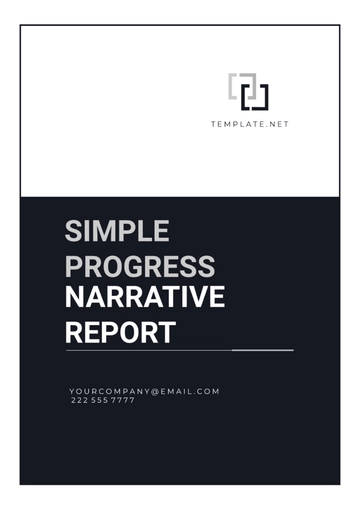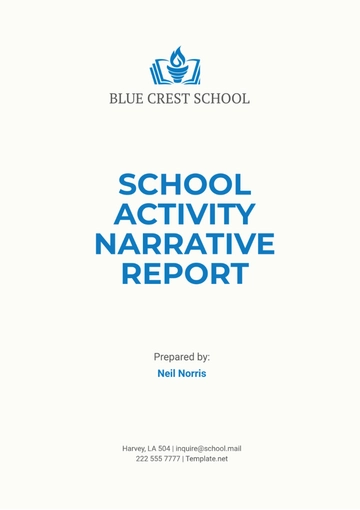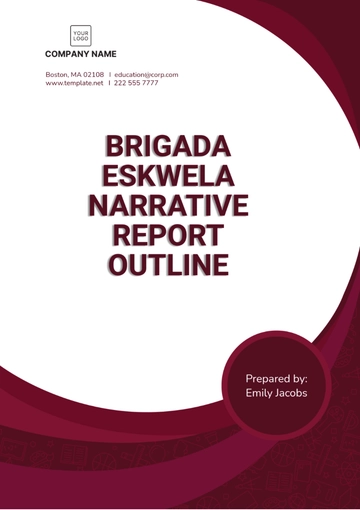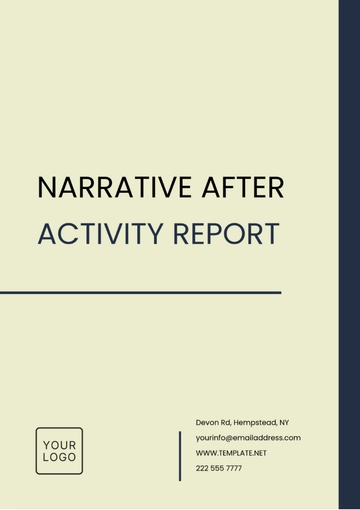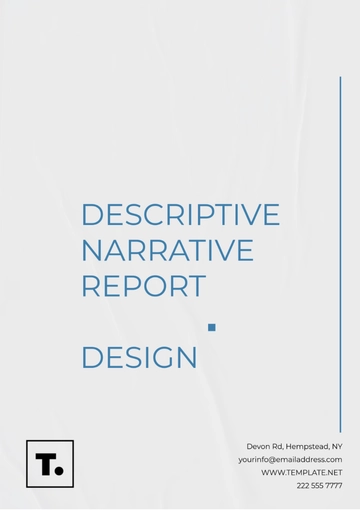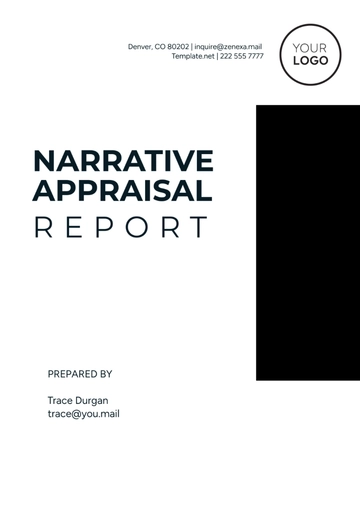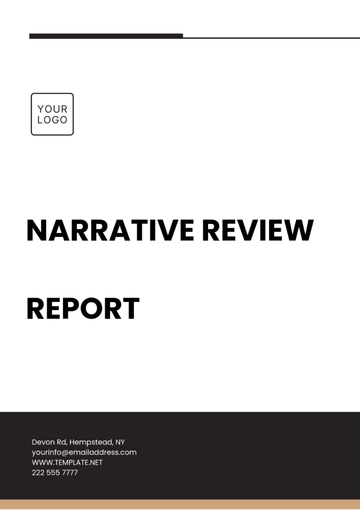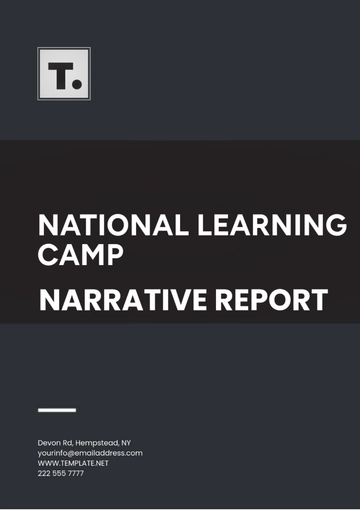Free Detailed Narrative Report
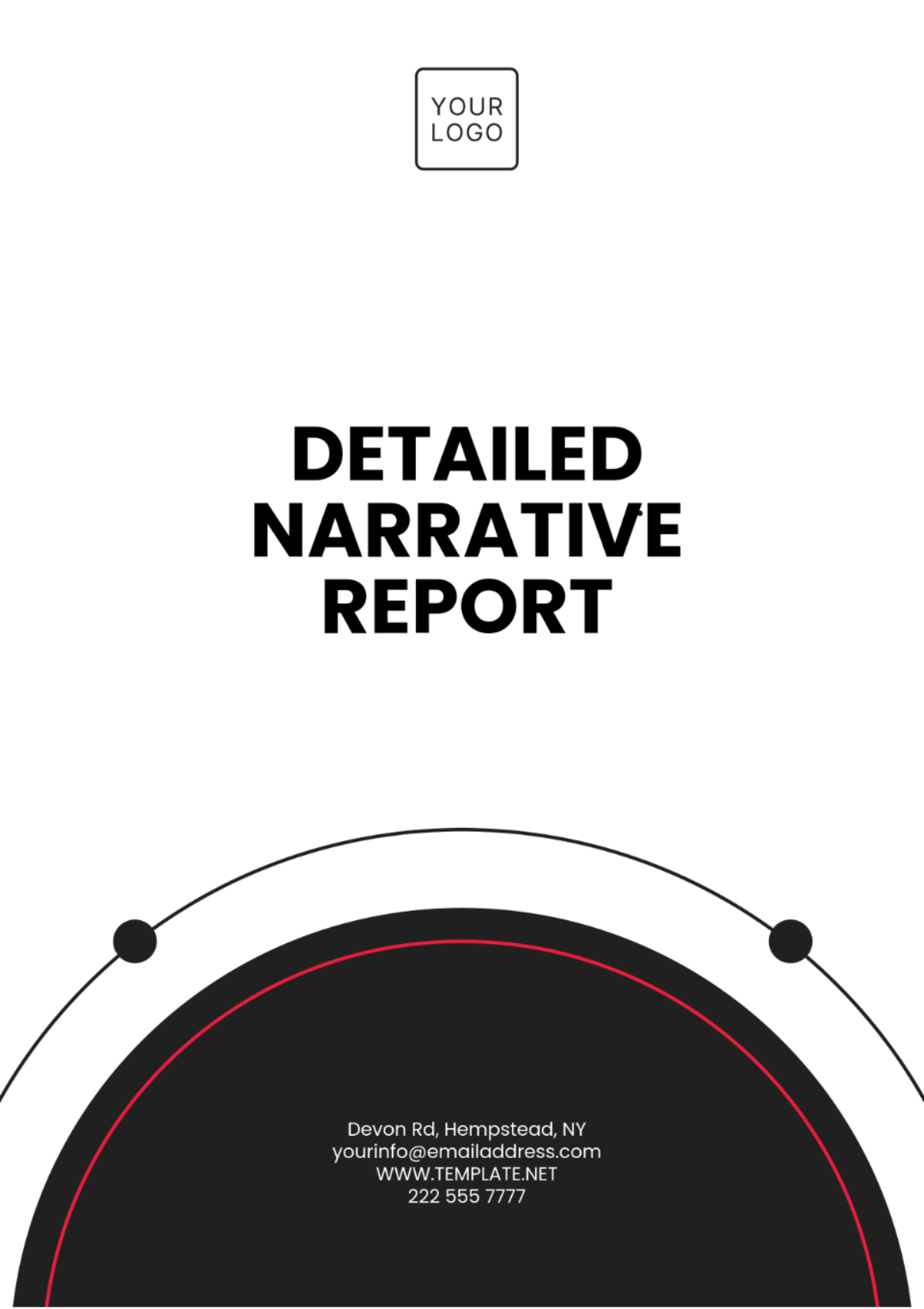
PREPARED BY: [YOUR NAME]
Company: [YOUR COMPANY NAME]
Date: October 24, 2054
Executive Summary
This report presents a detailed narrative case study of [YOUR COMPANY NAME], a pioneering company that has successfully transformed the renewable energy sector through its innovative solar technology solutions. This case study analyzes the company's strategic initiatives, market growth, and broader implications for the renewable energy industry, particularly in urban environments.
[YOUR COMPANY NAME], established in 2050, focuses on delivering sustainable solar energy solutions that are both affordable and efficient. Over four years, the company has achieved remarkable growth, leading to increased adoption of solar technology across various urban demographics. The findings highlight key factors that contributed to its success, including strategic partnerships, financing options, and community engagement programs.
The report concludes with recommendations for further expansion and sustainability practices that can benefit both the company and the communities it serves.
1. Introduction
The purpose of this case study is to explore the impact of [YOUR COMPANY NAME]’ solar technology on urban energy consumption and sustainability. As cities grapple with increasing energy demands and environmental concerns, [YOUR COMPANY NAME] has positioned itself as a leader in providing innovative solutions that meet both consumer needs and sustainability goals.
This report will detail the significant events, strategic decisions, and findings related to the company’s growth from its inception in 2050 to its current market leadership position in 2054. The narrative will emphasize the critical elements that contributed to [YOUR COMPANY NAME]’s success, including technological advancements, customer engagement strategies, and effective market positioning.
2. Background
In 2050, the global demand for sustainable energy solutions surged, primarily driven by the escalating energy crisis in urban areas and increasing awareness of climate change. [YOUR COMPANY NAME] was founded with the mission to develop affordable, efficient solar energy solutions to address these challenges.
Company Vision and Mission
Vision: To become the leading provider of renewable energy solutions, promoting a sustainable future for urban environments.
Mission: To deliver innovative solar technology that is accessible to all, thereby reducing carbon footprints and promoting energy independence.
Industry Context
By 2050, the renewable energy market was valued at approximately $1 trillion, with solar energy accounting for over 30% of this market. As governments and organizations worldwide committed to reducing greenhouse gas emissions, the opportunity for solar technology grew exponentially.
[YOUR COMPANY NAME] emerged as a frontrunner by addressing several key pain points in the industry:
Cost Barriers: Traditional solar installations were often too expensive for average consumers.
Awareness and Education: Many potential users lacked understanding of solar technology benefits.
Regulatory Hurdles: Slow approval processes often delayed solar project implementations.
Year | Event/Development | Description |
|---|---|---|
2050 | Launch of Solar Panel Series | [YOUR COMPANY NAME] launched its flagship solar panel series, offering 25% more efficiency than existing products, utilizing cutting-edge photovoltaic technology. |
2051 | Partnership with City of Metropolis | The company partnered with the city government to install solar panels on public buildings, demonstrating the technology’s viability and benefits to citizens. |
2052 | Expansion to Residential Market | Introduction of a consumer-friendly solar panel financing program, increasing accessibility for low- to middle-income households. |
2053 | Community Outreach Program | Aimed at educating residents about solar benefits, leading to a 40% increase in community interest and installations. |
2054 | Award for Innovation in Sustainability | [YOUR COMPANY NAME] received the National Sustainability Award for its contributions to renewable energy, further enhancing its brand reputation. |
3. Methodology
This case study employs a mixed-methods approach, integrating both qualitative and quantitative research methodologies. The aim is to provide a comprehensive analysis of [YOUR COMPANY NAME]’ growth and the factors contributing to its success.
Data Collection Methods
Interviews: In-depth interviews were conducted with key stakeholders, including executives at [YOUR COMPANY NAME], city planners, and customers, to gather insights on the company's strategies and customer perceptions.
Surveys: A structured survey was administered to over 1,000 residential customers to assess satisfaction levels, awareness, and the impact of financing options.
Site Visits: Observations of installation sites provided qualitative insights into the practical aspects of solar panel deployment and customer interactions.
Secondary Data Analysis: Industry reports, market analysis, and academic journals were reviewed to contextualize [YOUR COMPANY NAME]’s performance within the broader renewable energy landscape.
Sample Size and Demographics
Survey Participants: 1,000 residential customers in urban areas, ages 25-65.
Interview Subjects: 10 key stakeholders, including:
3 Executive Team Members
2 City Planners
5 Residential Customers
4. Findings
4.1 Key Findings
The analysis yielded several key findings related to [YOUR COMPANY NAME]’s business model and market success:
Finding 1: The introduction of financing options significantly increased residential adoption rates by 60% in just two years.
Finding 2: Community outreach programs resulted in a 40% increase in public awareness about solar energy benefits and usability.
Finding 3: Partnerships with local governments accelerated project approvals, reducing installation time by 30%, thereby enhancing customer satisfaction and operational efficiency.
Finding | Details |
|---|---|
Finding 1 | Financing options allowed families to afford solar energy without upfront costs, increasing accessibility and promoting widespread adoption. |
Finding 2 | Education initiatives helped dispel myths about solar technology and its viability, leading to greater consumer confidence in purchasing decisions. |
Finding 3 | Collaborative efforts with city planners streamlined processes, benefiting both the community and the company, enabling quicker implementation of solar projects. |
4.2 Financial Performance
[YOUR COMPANY NAME]’s financial performance over the past four years indicates significant growth, with year-over-year revenue increases.
Year | Revenue (in millions) | Growth Rate (%) |
|---|---|---|
2050 | $10 | - |
2051 | $18 | 80% |
2052 | $30 | 67% |
2053 | $50 | 67% |
2054 | $75 | 50% |
5. Analysis
5.1 Implications for the Industry
The findings from [YOUR COMPANY NAME] have several implications for the renewable energy industry:
Cost Accessibility: Financial products like solar leasing and loans can significantly reduce barriers to entry for potential customers, making solar energy a feasible option for more households.
Community Engagement: Proactive community outreach initiatives can play a crucial role in increasing public awareness and acceptance of renewable energy solutions.
Government Collaboration: Effective partnerships with government entities can streamline regulatory processes and facilitate faster project implementations.
5.2 Lessons Learned
Innovative Financing is Key: The success of [YOUR COMPANY NAME]’s financing model demonstrates the importance of providing flexible payment options to attract a diverse customer base.
Educate to Engage: Continuous education and outreach efforts are vital in shifting consumer perceptions and enhancing market acceptance of new technologies.
Adaptability and Responsiveness: The ability to quickly adapt to customer feedback and market demands is crucial for sustained growth and competitive advantage.
6. Conclusions and Recommendations
In conclusion, this case study highlights [YOUR COMPANY NAME]’s effective strategies in revolutionizing urban energy consumption through solar technology. The company has successfully positioned itself as a leader in the renewable energy sector by implementing customer-centric practices and fostering strong community relationships.
Based on the findings, the following recommendations are made:
Recommendation 1: Expand financing options to underserved communities to further increase solar panel adoption and ensure equitable access to renewable energy.
Recommendation 2: Continue and expand community outreach initiatives to educate the public about the long-term benefits of solar energy and to counteract misinformation.
Recommendation 3: Strengthen partnerships with local governments and organizations to enhance collaboration and streamline processes, further increasing operational efficiency.
7. Appendices
Appendix A: Survey Results
Question | Response Options | Results |
|---|---|---|
How satisfied are you with [YOUR COMPANY NAME]'s solar panels? | Very Satisfied, Satisfied, Neutral, Dissatisfied, Very Dissatisfied | 75% Very Satisfied |
Would you recommend [YOUR COMPANY NAME] to others? | Yes, No | 90% Yes |
What factors influenced your decision to purchase? | Price, Quality, Financing Options, Community Initiatives | 55% Financing Options |
Appendix B: Interview Transcripts
Interviewee 1 (CEO of [YOUR COMPANY NAME]): "Our focus on community engagement has transformed how residents view solar energy, making it a viable option for many. We've seen firsthand how education drives interest and installations."
Interviewee 2 (City Planner): "Working with [YOUR COMPANY NAME] has streamlined our sustainability initiatives, allowing us to meet our energy goals ahead of schedule. Their responsiveness and innovative approach have set a new standard for public-private partnerships."
Interviewee 3 (Customer): "I never thought I could afford solar panels. The financing option changed everything for me and my family. Now, we’re saving money on our energy bills!"
Appendix C: Additional Resources
[YOUR COMPANY NAME] Website: [YOUR COMPANY WEBSITE]
National Renewable Energy Laboratory: www.nrel.fict
Renewable Energy World: www.renewableenergyworld.fict
References
Smith, J. (2053). Renewable Energy Trends: 2050 and Beyond. Green Energy Publications.
Brown, A. (2054). The Impact of Solar Energy on Urban Development. Journal of Sustainable Cities.
[YOUR COMPANY NAME]. (2054). Annual Sustainability Report 2054.
U.S. Department of Energy. (2054). 2024 Energy Outlook: The Future of Solar Energy.
International Renewable Energy Agency. (2053). Solar Energy Capacity: Trends and Innovations.
- 100% Customizable, free editor
- Access 1 Million+ Templates, photo’s & graphics
- Download or share as a template
- Click and replace photos, graphics, text, backgrounds
- Resize, crop, AI write & more
- Access advanced editor
Unlock the power of storytelling with our Detailed Narrative Report Template from Template.net. This fully editable and customizable tool allows you to effortlessly craft compelling narratives tailored to your needs. Whether for business or personal use, leverage our AI Editable Tool to enhance clarity and engagement in your reports. Transform your ideas into impactful stories today!
You may also like
- Sales Report
- Daily Report
- Project Report
- Business Report
- Weekly Report
- Incident Report
- Annual Report
- Report Layout
- Report Design
- Progress Report
- Marketing Report
- Company Report
- Monthly Report
- Audit Report
- Status Report
- School Report
- Reports Hr
- Management Report
- Project Status Report
- Handover Report
- Health And Safety Report
- Restaurant Report
- Construction Report
- Research Report
- Evaluation Report
- Investigation Report
- Employee Report
- Advertising Report
- Weekly Status Report
- Project Management Report
- Finance Report
- Service Report
- Technical Report
- Meeting Report
- Quarterly Report
- Inspection Report
- Medical Report
- Test Report
- Summary Report
- Inventory Report
- Valuation Report
- Operations Report
- Payroll Report
- Training Report
- Job Report
- Case Report
- Performance Report
- Board Report
- Internal Audit Report
- Student Report
- Monthly Management Report
- Small Business Report
- Accident Report
- Call Center Report
- Activity Report
- IT and Software Report
- Internship Report
- Visit Report
- Product Report
- Book Report
- Property Report
- Recruitment Report
- University Report
- Event Report
- SEO Report
- Conference Report
- Narrative Report
- Nursing Home Report
- Preschool Report
- Call Report
- Customer Report
- Employee Incident Report
- Accomplishment Report
- Social Media Report
- Work From Home Report
- Security Report
- Damage Report
- Quality Report
- Internal Report
- Nurse Report
- Real Estate Report
- Hotel Report
- Equipment Report
- Credit Report
- Field Report
- Non Profit Report
- Maintenance Report
- News Report
- Survey Report
- Executive Report
- Law Firm Report
- Advertising Agency Report
- Interior Design Report
- Travel Agency Report
- Stock Report
- Salon Report
- Bug Report
- Workplace Report
- Action Report
- Investor Report
- Cleaning Services Report
- Consulting Report
- Freelancer Report
- Site Visit Report
- Trip Report
- Classroom Observation Report
- Vehicle Report
- Final Report
- Software Report
